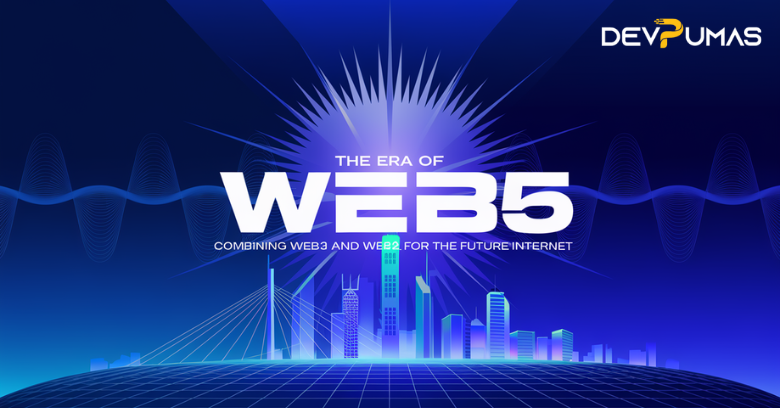Introduction: What is the Era of Web5?
The internet has undergone significant transformations since its inception. Web1 brought static, read-only content. Web2 introduced dynamic, user-generated content and centralized platforms like social media. Web3 revolutionized the landscape with blockchain technology and decentralization. Now, we are entering the era of Web5, a concept that aims to merge the best of Web2’s usability with Web3’s decentralization to create a truly user-centric internet experience.
The era of Web5 focuses on restoring user ownership, enhancing privacy, and creating seamless decentralized applications (dApps). By combining the strengths of its predecessors, Web5 has the potential to revolutionize how we interact with the internet, making it more secure, accessible, and empowering for individuals.
1. Understanding the Evolution: From Web1 to Web5
The development of the Internet can be categorized into distinct phases:
Web1: The Static Web
- Timeline: 1990s to early 2000s
- Features: Read-only websites with minimal interactivity.
- Limitations: Limited to information consumption, lacking personalization or dynamic features.
Web2: The Interactive Web
- Timeline: Early 2000s to present
- Features: Social media, e-commerce, and user-generated content dominate this phase. Centralized platforms like Facebook and YouTube became the norm.
- Limitations: Concerns over privacy, data ownership, and monopolistic practices by tech giants.
Web3: The Decentralized Web
- Timeline: Emerging since the late 2010s
- Features: Blockchain technology enables decentralized apps (dApps), smart contracts, and token-based ecosystems.
- Limitations: Steep learning curves, scalability issues, and fragmented user experiences.
Web5: The Convergence of Web2 and Web3
- Vision: Merging Web2’s user-friendly interfaces with Web3’s decentralized infrastructure.
- Objective: Create a seamless, user-owned, and privacy-centric internet experience.
The era of Web5 represents a shift towards a more inclusive and functional Internet, addressing the shortcomings of both Web2 and Web3.
2. What Sets Web5 Apart?
The unique aspects of the era of Web5 lie in its focus on:
2.1 User Ownership
Web5 emphasizes giving users full control over their data, identities, and digital assets, eliminating reliance on centralized platforms.
2.2 Interoperability
Web5 fosters seamless communication between decentralized applications, bridging the gaps that often exist in Web3 ecosystems.
2.3 Enhanced Usability
By combining Web2’s intuitive design principles with Web3’s decentralized backend, Web5 aims to deliver a user-friendly experience.
2.4 Privacy by Default
Privacy is a core principle of Web5, achieved through cryptographic methods and decentralized identity frameworks.
3. Key Technologies Driving the Era of Web5
Several cutting-edge technologies contribute to the realization of Web5’s vision:
3.1 Blockchain and Distributed Ledgers
Blockchain technology provides the foundation for decentralization, enabling secure peer-to-peer transactions and smart contracts.
3.2 Decentralized Identifiers (DIDs)
DIDs allow users to create and manage their digital identities independently of centralized authorities.
3.3 Decentralized Storage
Technologies like IPFS (InterPlanetary File System) ensure that data is stored securely and redundantly without central points of failure.
3.4 Zero-Knowledge Proofs
These cryptographic techniques enhance privacy by proving the validity of information without revealing sensitive data.
4. Decentralized Identity and Data Ownership
One of the hallmarks of the era of Web5 is its emphasis on decentralized identity and data ownership.
4.1 Self-Sovereign Identity (SSI)
SSI empowers users to own and control their digital identities without relying on intermediaries. This concept ensures that:
- Users can selectively share information.
- Identity theft risks are minimized.
- Digital interactions remain private and secure.
4.2 Personal Data Pods
Personal data pods allow individuals to store and manage their data independently, granting access to third parties only when necessary.
4.3 Impact on Businesses
For businesses, decentralized identity frameworks simplify compliance with data protection regulations like GDPR while fostering trust with users.
5. Web5 Use Cases: Beyond Blockchain
The era of Web5 expands decentralized applications beyond traditional blockchain use cases:
5.1 Decentralized Social Media
Platforms like BlueSky aim to create user-owned social networks, eliminating concerns over censorship and data monetization.
5.2 Decentralized Finance (DeFi) 2.0
Web5 introduces more accessible and intuitive financial services, addressing the complexities of current DeFi systems.
5.3 Supply Chain Transparency
Decentralized systems enable real-time tracking of goods, ensuring transparency and accountability across supply chains.
5.4 Content Creation and Monetization
Web5 allows creators to directly monetize their content without intermediaries, ensuring fair revenue distribution.
6. Challenges to Adopting Web5
Despite its potential, Web5 faces several hurdles:
6.1 Technical Complexity
Building and maintaining decentralized applications require advanced technical expertise, which may limit adoption.
6.2 Scalability Issues
Decentralized networks often struggle to handle large-scale transactions efficiently.
6.3 User Awareness
Educating users about the benefits and functionality of Web5 is critical for widespread adoption.
6.4 Regulatory Concerns
Navigating the legal and regulatory landscape remains a challenge, particularly in jurisdictions with strict data and financial laws.
7. Future Trends Shaping the Era of Web5
The evolution of Web5 will be influenced by several emerging trends:
7.1 AI-Driven Decentralization
AI can optimize decentralized networks, improving performance and scalability.
7.2 Green Blockchain Initiatives
Sustainability-focused technologies will reduce the environmental impact of decentralized networks.
7.3 Cross-Platform Integration
Web5 will foster interoperability between traditional and decentralized systems, ensuring seamless transitions for users.
8. How Businesses Can Prepare for Web5
8.1 Invest in Decentralized Infrastructure
Adopting decentralized technologies like blockchain and IPFS ensures businesses stay competitive in the era of Web5.
8.2 Enhance User Education
Providing educational resources helps users understand and adopt Web5 technologies.
8.3 Focus on Privacy and Security
Implementing privacy-centric solutions fosters trust and compliance with evolving regulations.
8.4 Collaborate with Innovators
Partnering with decentralized tech startups accelerates innovation and adoption.
Wrapping It Up: Embracing the Era of Web5
The transition to the era of Web5 marks a pivotal moment in the internet’s evolution. By combining the user-centric principles of Web2 with the decentralization of Web3, Web5 promises a future where individuals have greater control over their digital experiences.
For businesses and developers, embracing Web5 is not just an opportunity—it’s a necessity to stay relevant in a rapidly changing digital landscape. By investing in decentralized technologies, prioritizing user privacy, and fostering innovation, organizations can thrive in this exciting new era of the internet.



